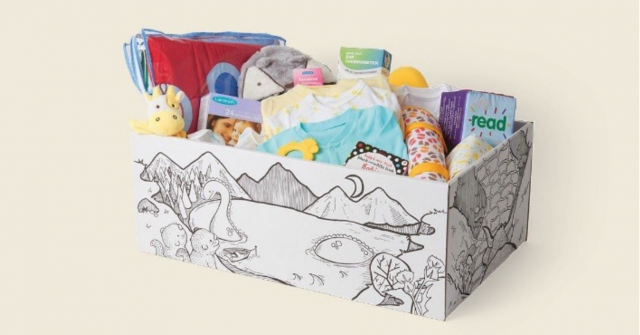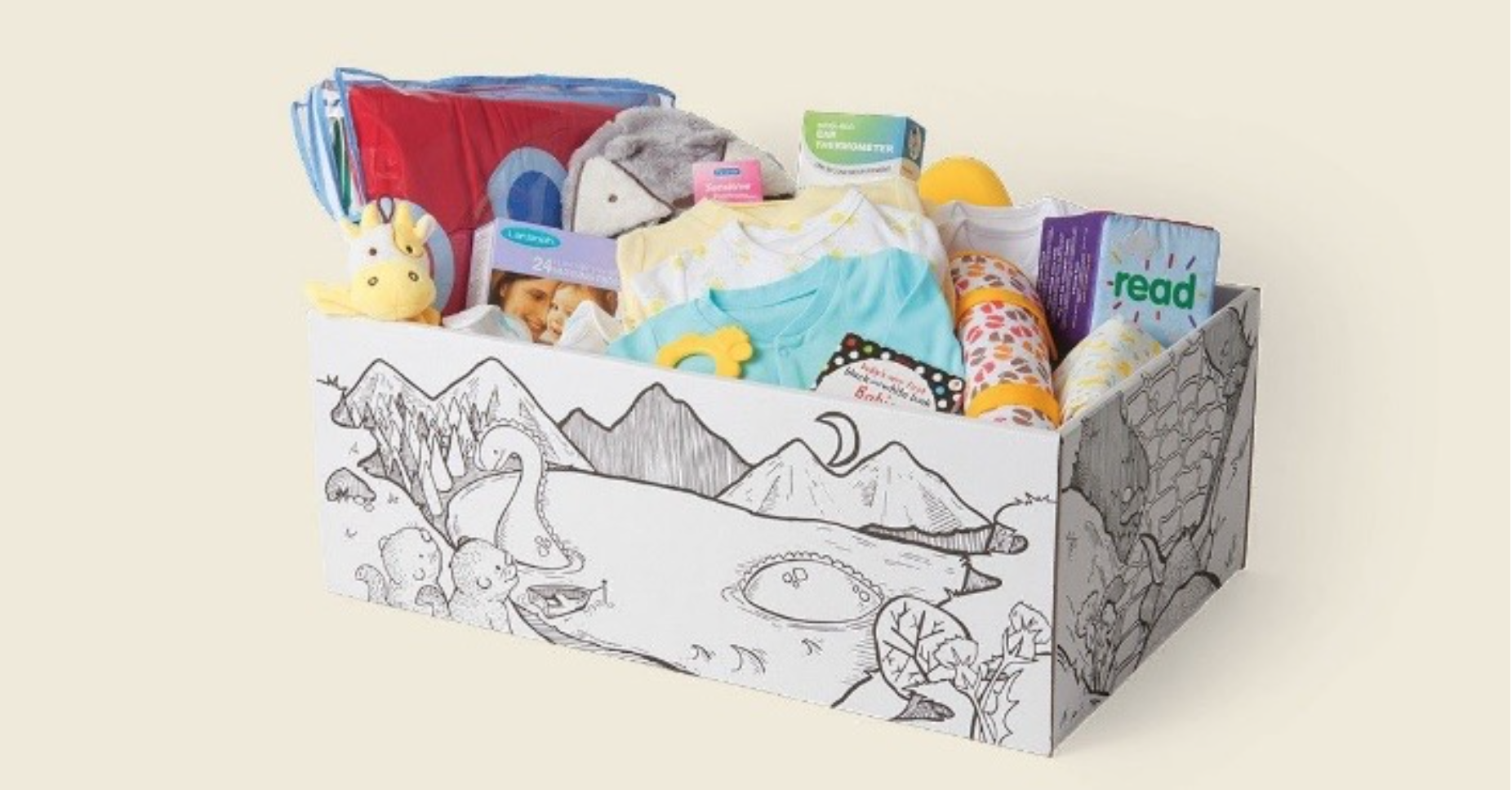This blog post reports on work-in-progress within the DfG course! The post is written by the group dealing with the Ministry of Economic Affairs and Employment’s brief on ‘Reducing the carbon footprint of procurement services’.
—
Group 2A: Xinghua Meng, Kalle Kaisko, Michael Buchta from the Creative Sustainability program and Amandine Fong from the Collaborative and Industrial Design program.
THE MATERNITY PACKAGE, A CASE STUDY FOR INNOVATIVE AND SUSTAINABLE PROCUREMENT
Each year, Kela (the Social Insurance Institution of Finland), a “government agency that provides basic economic security for everyone in Finland”[1], provides 30 000 maternity packages. The maternity package covers essential items for welcoming a new member to the family. The selection of companies is done through an open public bidding process. Companies specialized in Fashion, health, and care industries are invited to participate.
As the impacts of our activities on the environment are becoming more visible, it is crucial to rethink our consumption of goods and resources. With this in mind, Finland is aiming to be carbon neutral by 2035. Non-Governmental organization are also playing a key role in sustainable change. By conducting independent research on companies and public organization, they can influence companies, economic regulation, and public discourse. Recently, a report from Finnwatch reprimanded Kela for overlooking responsibility and sustainability in its competitive bidding criteria. This created discussion within Kela and some changes were made to the maternity box.
To go further, the Ministry of Economic Affairs and Employment (TEM), KELA, and KEINO (a network-based Competence centre for Sustainable and Innovative public procurement in Finland) are willing to develop innovative public procurement and improve productivity, quality, sustainability, and effectiveness of public services.
The maternity box is a good embodiment of the Finnish welfare state and has been part of Finnish culture since 1949. By developing an innovative procurement process focusing on sustainability for the maternity package, the commissioners aim to set an example of sustainable and innovative public procurement. Its impact could go way beyond the baby box. Indeed, the procurement process, developed for the baby box, could be extended to other public procurement and thus be a lever for sustainable change and consumption at a national scale.
MEETING FOR THE FIRST TIME?
“The biggest problem is the procurement process.”
“The process is a lot of work and very hard to even understand.”
“The products are also not wanted as second-hand, because practically everyone already has them.”
– Quotes from the roundtable discussion.
This week, we hosted a roundtable with the different stakeholders; members from Kela, TEM, Keino, and Syke (Finnish Environment Institute) were part of the discussion. Through this roundtable, we aimed to get a better understanding of the existing procurement process, its challenges, the role of each stakeholder, their ambition, and the content of the baby box.
To start, it seems that it was one of the first times the different stakeholders were meeting altogether. The discussion was dynamic, and all the stakeholders participated actively.
One of the key highlights of the discussion was the complexity of the procurement process for the companies, and the limitation regarding possible change due to existing laws from Kela and the public legislation. As equality is one of the core values of the maternity package, introducing re-used items seems to be challenging. Indeed, re-used items will differ from one another, making it difficult for Kela to ensure standard quality and regularity of all the items. Members of Syke also highlighted the need for assessing the carbon footprint of the different companies participating in the procurement. It is therefore valuable to define who will be responsible for calculating the carbon footprint as it can be challenging and time-consuming for the companies.
THE MATERNITY PACKAGE: FINLAND AND BEYOND
This week, we attended a talk organized by the Finnish Institute: The Finnish Baby Box goes Global. The talk highlighted how the concept of the maternity box spread all around the world. Sustainability is one of the current focuses regarding the development of maternity packages in other European countries. It was interesting to see other countries’ points of view on the current issue and what alternatives they tried to implement. In Scotland, they tried to include reusable nappies in the maternity package. However, as the uptake was low, they developed a voucher system, through which interested parents could get reusable nappies supplied by the company TotsBots.


THE BEST IS YET TO COME :))
To conclude, these first two weeks were quite intense. A lot of information was provided by the commissioners. The roundtable enabled us to get valuable insights, and a better comprehension of the existing system, its challenges, and its possibilities. Next week we will focus on qualitative research. To deepen our knowledge and grasp the entire complexity of the system, we will conduct interviews and workshops with the different stakeholders. We are also looking forward to the upcoming week as we will meet with producers of products of the baby box and leading producers in sustainable production. Their vision and experience will be essential in developing an impactful solution.
[1] https://www.kela.fi/web/en/about-kela
—


Feedback to group 2A. From Ruta Jumite (1B)
Dear group 2A!
Thank you for the insightful blog post. The writing style and the flow of the blog are very clear and easy to follow, providing comprehensive background information about maternity boxes.
As is emphasised in the blog post, the procurement process is a very challenging part of the product-service system of maternity boxes, therefore it is challenging to innovate towards more sustainable procurement in general. However, the benchmarking example of Scottish maternity boxes inspires to think about possible innovation. By having in mind the end goal of the product-service system, I would encourage you to step into very innovative areas and think about possibilities and challenges to introduce a service system that supports 100% reused items. What would be the challenges? Is there any stigma around reused items, and how could we address it? What policies should be changed or what new stakeholders should be considered to create a service system that promotes sharing and reusing instead of using virgin materials and new items. Maybe there are already existing services or sharing platforms that can be considered as possible collaborators.
In addition, I would encourage you to think about the preferable utopic solution and system. And from that point-of-view to use the LCA approach to analyze the week points of the system and possible challenges to introduce a circular economy strategy and close the loop. This process could lead to questions like, what is the predicted population growth within following years in Finland, and if it is (for example) decreasing, maybe there is some opportunity to create some international partnerships. Also, if we would aim to “close the loop”, what would be the limits to it? How many kids could wear particular items? What could we do with them at the end of their life? What would be the preferred supply chains for the raw materials and new items when there will be a need for them? How can we extend the life span of the items?
To summarise, the overall thinking about the case, system, and challenges related to it seems very clear and well argued. Keep up the excellent work!